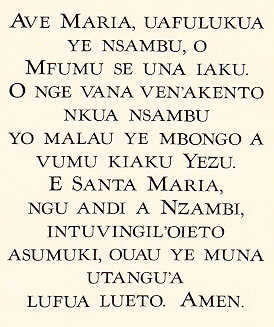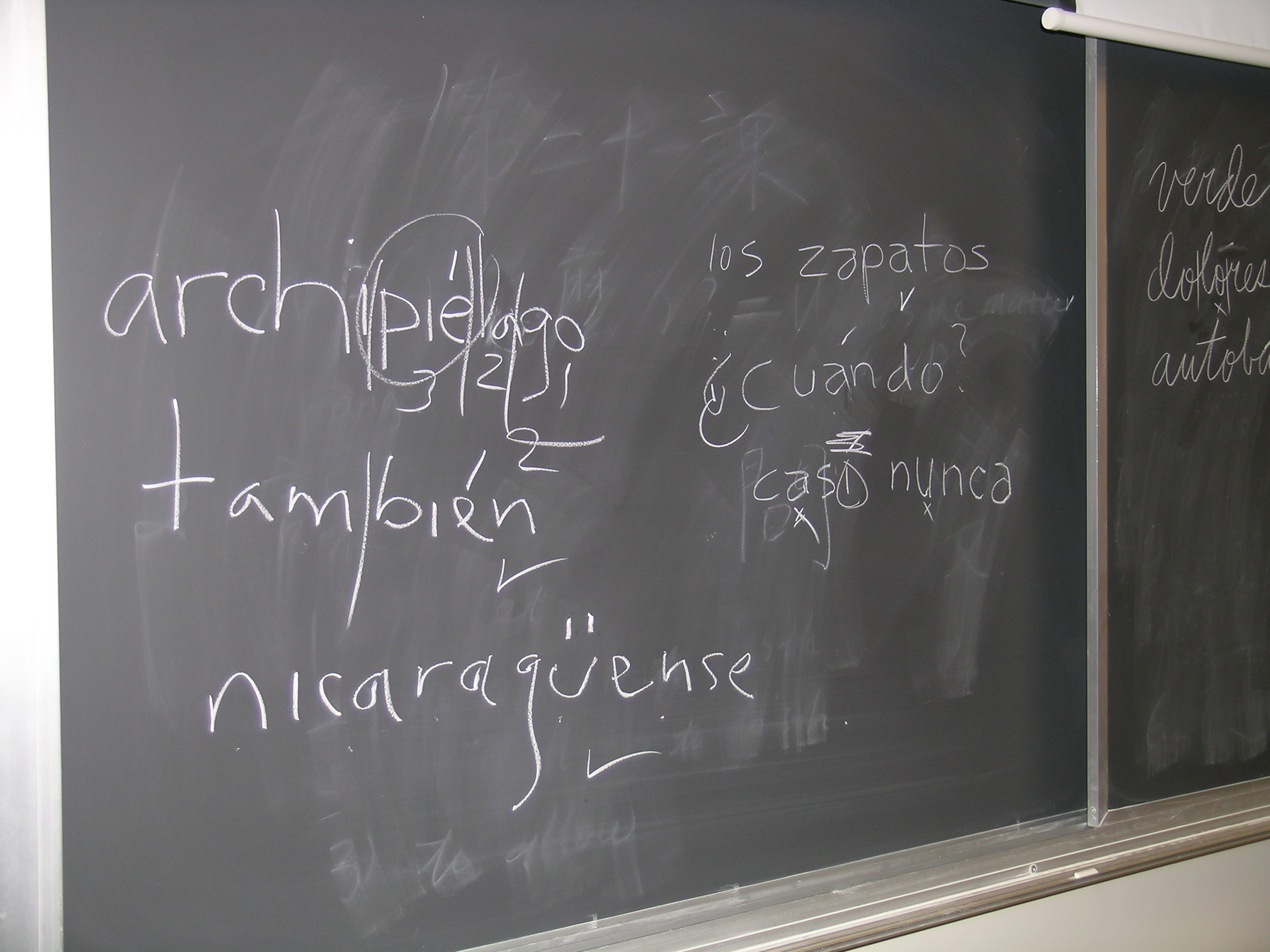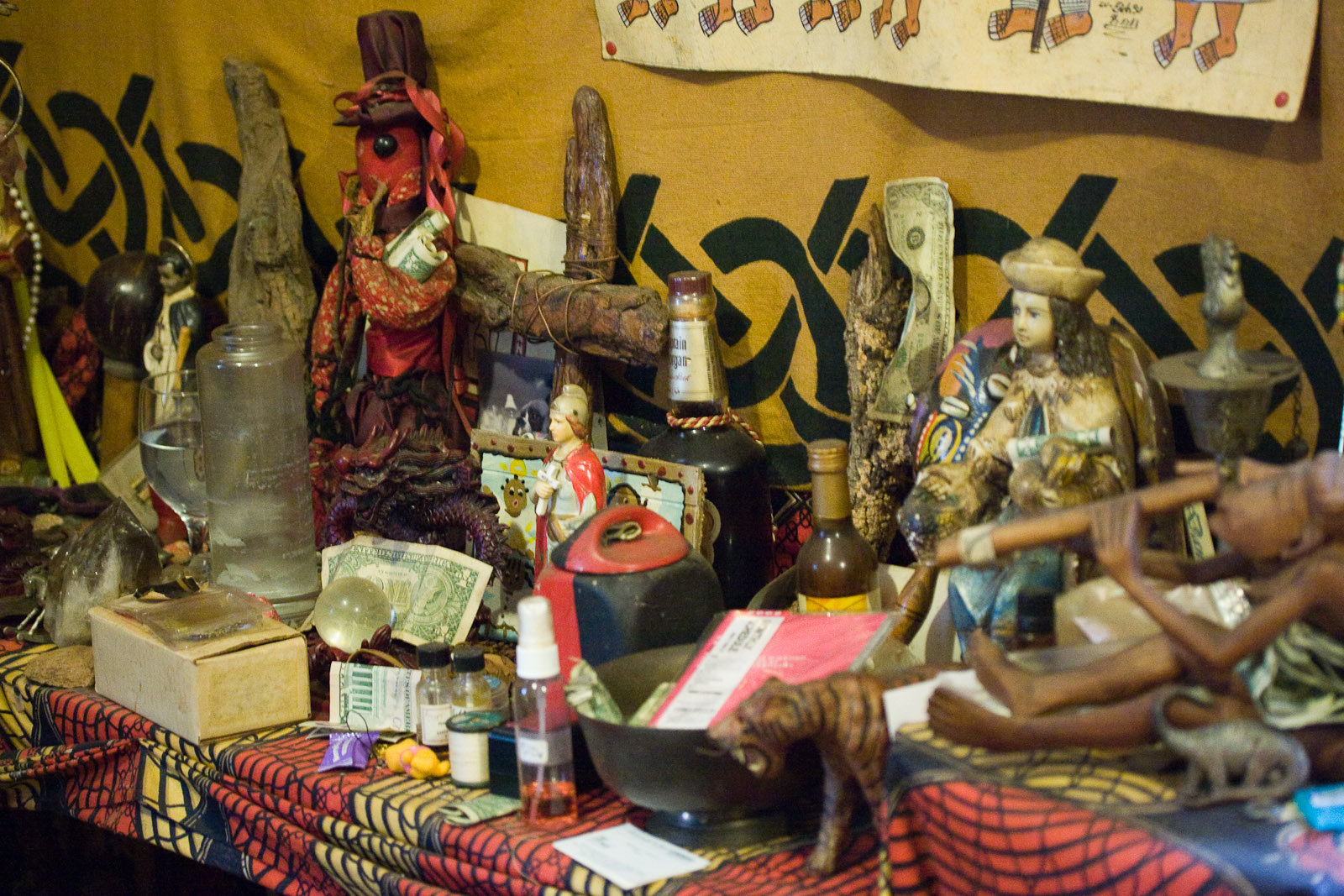|
KiKongo
Kongo or Kikongo is one of the Bantu languages spoken by the Kongo people living in the Democratic Republic of the Congo, the Republic of the Congo, Gabon and Angola. It is a tonal language. It was spoken by many of those who were taken from the region and sold as slaves in the Americas. For this reason, while Kongo still is spoken in the above-mentioned countries, creolized forms of the language are found in ritual speech of Afro-American religions, especially in Brazil, Cuba, Puerto Rico, the Dominican Republic and Haiti. It is also one of the sources of the Gullah language and the Palenquero creole in Colombia. The vast majority of present-day speakers live in Africa. There are roughly seven million native speakers of Kongo, with perhaps two million more who use it as a second language. Geographic distribution Kongo was the language of the Kingdom of Kongo prior to the creation of Angola by the Portuguese Crown in 1575 and the Berlin Conference (1884-1885) that balkanized the ... [...More Info...] [...Related Items...] OR: [Wikipedia] [Google] [Baidu] |
Kingdom Of Kongo
The Kingdom of Kongo ( kg, Kongo dya Ntotila or ''Wene wa Kongo;'' pt, Reino do Congo) was a kingdom located in central Africa in present-day northern Angola, the western portion of the Democratic Republic of the Congo, and the Republic of the Congo. At its greatest extent it reached from the Atlantic Ocean in the west to the Kwango River in the east, and from the Congo River in the north to the Kwanza River in the south. The kingdom consisted of several core provinces ruled by the ''Manikongo'', the Portuguese version of the Kongo title ''Mwene Kongo'', meaning "lord or ruler of the Kongo kingdom", but its sphere of influence extended to neighbouring kingdoms, such as Ngoyo, Kakongo, Loango, Ndongo and Matamba, the latter two located in what is Angola today. From c. 1390 to 1862 it was an independent state. From 1862 to 1914 it functioned intermittently as a vassal state of the Kingdom of Portugal. In 1914, following the Portuguese suppression of a Kongo revolt, Portugal abol ... [...More Info...] [...Related Items...] OR: [Wikipedia] [Google] [Baidu] |
Latin Script
The Latin script, also known as Roman script, is an alphabetic writing system based on the letters of the classical Latin alphabet, derived from a form of the Greek alphabet which was in use in the ancient Greek city of Cumae, in southern Italy ( Magna Grecia). It was adopted by the Etruscans and subsequently by the Romans. Several Latin-script alphabets exist, which differ in graphemes, collation and phonetic values from the classical Latin alphabet. The Latin script is the basis of the International Phonetic Alphabet, and the 26 most widespread letters are the letters contained in the ISO basic Latin alphabet. Latin script is the basis for the largest number of alphabets of any writing system and is the most widely adopted writing system in the world. Latin script is used as the standard method of writing for most Western and Central, and some Eastern, European languages as well as many languages in other parts of the world. Name The script is either called Latin script ... [...More Info...] [...Related Items...] OR: [Wikipedia] [Google] [Baidu] |
Second Language
A person's second language, or L2, is a language that is not the native language (first language or L1) of the speaker, but is learned later. A second language may be a neighbouring language, another language of the speaker's home country, or a foreign language. A speaker's dominant language, which is the language a speaker uses most or is most comfortable with, is not necessarily the speaker's first language. For example, the Canadian census defines first language for its purposes as "the first language learned in childhood and still spoken", recognizing that for some, the earliest language may be lost, a process known as language attrition. This can happen when young children start school or move to a new language environment. Second-language acquisition The distinction between acquiring and learning was made by Stephen Krashen (1982) as part of his Monitor Theory. According to Krashen, the ''acquisition'' of a language is a natural process; whereas ''learning'' a language is ... [...More Info...] [...Related Items...] OR: [Wikipedia] [Google] [Baidu] |
Colombia
Colombia (, ; ), officially the Republic of Colombia, is a country in South America with insular regions in North America—near Nicaragua's Caribbean coast—as well as in the Pacific Ocean. The Colombian mainland is bordered by the Caribbean Sea to the north, Venezuela to the east and northeast, Brazil to the southeast, Ecuador and Peru to the south and southwest, the Pacific Ocean to the west, and Panama to the northwest. Colombia is divided into 32 departments and the Capital District of Bogotá, the country's largest city. It covers an area of 1,141,748 square kilometers (440,831 sq mi), and has a population of 52 million. Colombia's cultural heritage—including language, religion, cuisine, and art—reflects its history as a Spanish colony, fusing cultural elements brought by immigration from Europe and the Middle East, with those brought by enslaved Africans, as well as with those of the various Amerindian civilizations that predate colonization. Spanish is th ... [...More Info...] [...Related Items...] OR: [Wikipedia] [Google] [Baidu] |
Palenquero
Palenquero (sometimes spelled Palenkero) or Palenque ( pln, Lengua) is a Spanish-based creole language spoken in Colombia. It is believed to be a mixture of Kikongo (a language spoken in central Africa in the current countries of Congo, DRC, Gabon, and Angola, former member states of Kongo) and Spanish. However, there is no sufficient evidence to indicate that Palenquero is strictly the result of a two-language contact. Palenquero is the only surviving Spanish-based creole language in Latin America, if Papiamento (which is often considered to be Portuguese-based) is excluded. Over 6,600 people spoke this language in 2018. It is primarily spoken in the village of San Basilio de Palenque which is southeast of Cartagena, and in some neighbourhoods of Barranquilla. History Origin The formation of Palenquero is recorded from the 17th century with the dilution of the Spanish language and the increase of maroon activity. There are existing records dating from the era of Carta ... [...More Info...] [...Related Items...] OR: [Wikipedia] [Google] [Baidu] |
Gullah Language
Gullah (also called Gullah-English, Sea Island Creole English, and Geechee) is a creole language spoken by the Gullah people (also called "Geechees" within the community), an African-American population living in coastal regions of South Carolina and Georgia (including urban Charleston and Savannah) as well as extreme northeastern Florida and the extreme southeast of North Carolina. Origins Gullah is based on different varieties of English and languages of Central Africa and West Africa. Scholars have proposed a number of theories about the origins of Gullah and its development: # Gullah developed independently on the Sea Islands off the coast of the Carolinas, Georgia, and Florida throughout the 18th and 19th centuries by enslaved Africans. They developed a language that combined grammatical, phonological, and lexical features of the nonstandard English varieties spoken by that region's white slaveholders and farmers in that region, along with those from numerous Western and ... [...More Info...] [...Related Items...] OR: [Wikipedia] [Google] [Baidu] |
Haiti
Haiti (; ht, Ayiti ; French: ), officially the Republic of Haiti (); ) and formerly known as Hayti, is a country located on the island of Hispaniola in the Greater Antilles archipelago of the Caribbean Sea, east of Cuba and Jamaica, and south of The Bahamas and the Turks and Caicos Islands. It occupies the western three-eighths of the island which it shares with the Dominican Republic. To its south-west lies the small Navassa Island, which is claimed by Haiti but is disputed as a United States territory under federal administration."Haiti" ''Encyclopædia Britannica''. Haiti is in size, the third largest country in the Caribbean by area, and has an estimated population of 11.4 million, making it the most populous country in the Caribb ... [...More Info...] [...Related Items...] OR: [Wikipedia] [Google] [Baidu] |
Dominican Republic
The Dominican Republic ( ; es, República Dominicana, ) is a country located on the island of Hispaniola in the Greater Antilles archipelago of the Caribbean region. It occupies the eastern five-eighths of the island, which it shares with Haiti, making Hispaniola one of only two Caribbean islands, along with Saint Martin, that is shared by two sovereign states. The Dominican Republic is the second-largest nation in the Antilles by area (after Cuba) at , and third-largest by population, with approximately 10.7 million people (2022 est.), down from 10.8 million in 2020, of whom approximately 3.3 million live in the metropolitan area of Santo Domingo, the capital city. The official language of the country is Spanish. The native Taíno people had inhabited Hispaniola before the arrival of Europeans, dividing it into five chiefdoms. They had constructed an advanced farming and hunting society, and were in the process of becoming an organized civilization. The Taínos also in ... [...More Info...] [...Related Items...] OR: [Wikipedia] [Google] [Baidu] |
Puerto Rico
Puerto Rico (; abbreviated PR; tnq, Boriken, ''Borinquen''), officially the Commonwealth of Puerto Rico ( es, link=yes, Estado Libre Asociado de Puerto Rico, lit=Free Associated State of Puerto Rico), is a Caribbean island and Unincorporated territories of the United States, unincorporated territory of the United States. It is located in the northeast Caribbean Sea, approximately southeast of Miami, Florida, between the Dominican Republic and the United States Virgin Islands, U.S. Virgin Islands, and includes the eponymous main island and several smaller islands, such as Isla de Mona, Mona, Culebra, Puerto Rico, Culebra, and Vieques, Puerto Rico, Vieques. It has roughly 3.2 million residents, and its Capital city, capital and Municipalities of Puerto Rico, most populous city is San Juan, Puerto Rico, San Juan. Spanish language, Spanish and English language, English are the official languages of the executive branch of government, though Spanish predominates. Puerto Rico ... [...More Info...] [...Related Items...] OR: [Wikipedia] [Google] [Baidu] |
Cuba
Cuba ( , ), officially the Republic of Cuba ( es, República de Cuba, links=no ), is an island country comprising the island of Cuba, as well as Isla de la Juventud and several minor archipelagos. Cuba is located where the northern Caribbean Sea, Gulf of Mexico, and Atlantic Ocean meet. Cuba is located east of the Yucatán Peninsula (Mexico), south of both the American state of Florida and the Bahamas, west of Hispaniola ( Haiti/Dominican Republic), and north of both Jamaica and the Cayman Islands. Havana is the largest city and capital; other major cities include Santiago de Cuba and Camagüey. The official area of the Republic of Cuba is (without the territorial waters) but a total of 350,730 km² (135,418 sq mi) including the exclusive economic zone. Cuba is the second-most populous country in the Caribbean after Haiti, with over 11 million inhabitants. The territory that is now Cuba was inhabited by the Ciboney people from the 4th millennium BC with the Gua ... [...More Info...] [...Related Items...] OR: [Wikipedia] [Google] [Baidu] |
Afro-American Religion
African diaspora religions are a number of related Pagan beliefs that developed in the Americas in various nations of the Caribbean, Latin America and the Southern United States. They derive from Pagan traditional African religions with some influence from other religious traditions, notably Christianity and Islam. Characteristics Afro-American religions involve ancestor veneration and include a creator deity along with a pantheon of divine spirits such as the Orisha, Loa, Vodun, Nkisi and Alusi, among others. In addition to the religious syncretism of these various African traditions, many also incorporate elements of Folk Catholicism including folk saints and other forms of Folk religion, Native American religion, Spiritism, Spiritualism, Shamanism (sometimes including the use of Entheogens) and European folklore. Various "doctoring" spiritual traditions also exist such as Obeah and Hoodoo which focus on spiritual health. African religious traditions in the Americas can va ... [...More Info...] [...Related Items...] OR: [Wikipedia] [Google] [Baidu] |
Americas
The Americas, which are sometimes collectively called America, are a landmass comprising the totality of North and South America. The Americas make up most of the land in Earth's Western Hemisphere and comprise the New World. Along with their associated islands, the Americas cover 8% of Earth's total surface area and 28.4% of its land area. The topography is dominated by the American Cordillera, a long chain of mountains that runs the length of the west coast. The flatter eastern side of the Americas is dominated by large river basins, such as the Amazon, St. Lawrence River–Great Lakes basin, Mississippi, and La Plata. Since the Americas extend from north to south, the climate and ecology vary widely, from the arctic tundra of Northern Canada, Greenland, and Alaska, to the tropical rain forests in Central America and South America. Humans first settled the Americas from Asia between 42,000 and 17,000 years ago. A second migration of Na-Dene speakers followed later ... [...More Info...] [...Related Items...] OR: [Wikipedia] [Google] [Baidu] |



